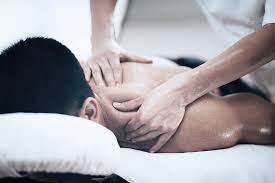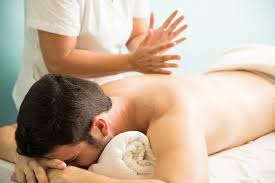Quality of touch
The quality of the touch you bring to a massage is as important as your technique. Try this exercise to help you experience “touch” in an immediate way: Sit quietly where you will not be disturbed. Think of someone you love and let that feeling flow down to your hands. Then, slowly place your hands on your face as lovingly as you would touch the person you love. Let the whole of your hand envelop the contours of your face and allow yourself to really feel the quality of the touch, its softness. caring, and the way these feelings are conveyed.
Spend some time covering all parts of your face and head in this way, allowing yourself to receive your own loving touch. These are the qualities to bring to your massage.

conveying intention Intention, focus, and presence are also vital ingredients in a good massage. To get in touch with these and get a taste of what you will be conveying to your partner; try this:
Sit comfortably with your eyes closed. Become aware of your breath, and as you inhale. bring your breath into your heart area (mid-chest); as you exhale, imagine the energy from your breath flowing out of your arms and hands, with the focus being the middle of your palms. Do this for five minutes, then bring your palms together, about ( I cm) apart. Focus on whatever the feeling is between the palms of your hands and try to describe to yourself as precisely as possible the sensation you experience. It is this energy and the connection between your palms that you need to bring to the massage and convey to your partner
massage chair The specially designed chair pictured here is ideal for supporting your partner comfortably while you work but an acceptable alternative is a kitchen chair on which your partner can sit or straddle. This gives more accessibility when massaging the back

WATCHWORDS
flow—Keep your strokes and movements smooth, flowing, and connected when moving from one part of the massage sequence to the other, without break or disruption.
feedback—Encourage your partner to give helpful or useful feedback such as “too deep” or “too light,” but otherwise conduct the massage in silence; this will enable you and your partner to share a deeper experience.
giving—Give yourself time to learn massage. taking one sequence at a time. Being aware of posture, breath, centering, and grounding will help you relax and enjoy the process. Once you have mastered the strokes and sequences you can allow your intuition to play a larger part; you may then find your hands devising their own movements and strokes more suitable and appropriate for the needs of the person you are massaging.
receiving—If you are receiving a massage. allow yourself to relax as deeply as possible. Let your attention rest lightly on your breathing and give yourself up to the movement of the massage and the enjoyment of the experience.




